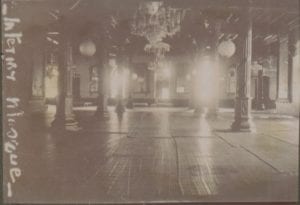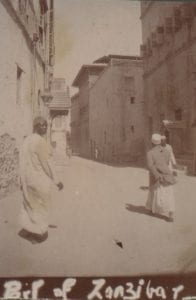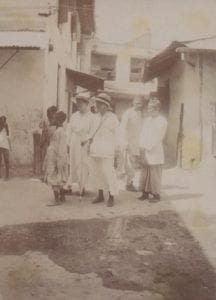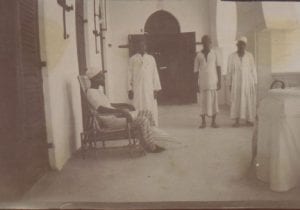Margaret Duncan’s diary: 28 March 1918
Posted on by Fay Curtis.
by Nicky Sugar, Archivist at Bristol Archives
In February 1918 Margaret Duncan, a Post Office clerk from Scotland, sailed to East Africa for a new job and new adventures. Her diary and photograph albums are now in the British Empire and Commonwealth Collection at Bristol Archives (ref: 2001/090/2). One hundred years on, we share her story for the first time.
Last month Margaret explored Dar es Salaam with Sergeant Jim White and enjoyed meeting his colleagues from the Telegraph Office. In this instalment, she lands in Zanzibar, the last stopover on her long voyage to Kenya. Some of the terms she uses to describe the people and areas she encounters would not be considered acceptable by today’s standards.
My diary
Zanzibar
Thursday 28 March 1918
The quaintest, most Oriental of towns this, narrow streets with high houses nodding to one another across the way, almost touching at times. Silent white robed Arabs, dusky Indians and Swahilis move about, in and out of that network of narrow weird looking streets.

Eleanor, Florence and I started off this morning after breakfast, determined to see what we could of Zanzibar. As our boat landed us on the beach the guides crowded round with their number discs and clamoured for the privilege of conducting us round.
I love to air my Swahili, but only know about half a dozen words as yet. We saw the Old Palace, now used as Government offices, next to it is the Old Harem. A short distance away stand the present Palace and Harem, not specially imposing.

Through a network of narrow streets, almost Closes and lanes, so narrow and crooked they are, we came to a Mohammedan Mosque.
Our guide told us that we might enter barefooted, but we just took off our shoes, they allowed stockings, although the native washed his feet before entering. It was very gaudy and hung with many coloured globes which must make a brilliant show when the lights are on. I took a photo in there and hope it is good, I took a good many today, having a camera lent me from Mr Cuss (known as Mr Zanzibar amongst us, because he left us here at Zanzibar.) We visited three rooms in the mosque, one specially for the women.
Past native shops or bazaars, where a moving throng of silent footed figures glided, the men in white robes, the women in colours, or robed in black gowns covering their faces (Moslem women). We reached the Old Slave Market, now used for the sale of fruit, meat, fish etc.

We bought some bananas at four for an anna, very good ones too. Next we went with our useful guide to hire a carriage, and then the three of us set off for a drive to Bu-Bu-Bu, first stopping at the Africa Hotel for drinks.
A few miles onwards we came to the Sultan’s country palace and were conducted through. It isn’t imposing, but very pretty, and beautifully furnished in black oak, the carving is wonderful. We took two snapshots on the balcony.
The drive back was delightful, we came through the purely native part as we entered the town, there was only just room for our carriage through the streets, there would be a “bust up” if two met.
We went to the “Africa” for tea and there met two “Clunies” Mr Watkins and Mr Anderson and we got the last photo taken of the crowd of us on the steps, the proprietor (a Greek I think) was pleased to oblige by taking it.

We are speeding along the coast now and soon Zanzibar will fade in the distance, so I must go and pack. The tour has been topping, we’ve seen such a lot, but all good things come to an end and Nairobi the goal of our ambition lies before us.
Next month Margaret finally arrives in Nairobi, and takes up residence in the Post Office Bungalow.
Did you know?
Zanzibar
Zanzibar was controlled by the Portuguese Empire and subsequently by the Sultanate of Oman, both of whom recognised its strategic importance as a trading post. The British developed an interest in the island in the 19th century, and pressured the Sultanate to abolish the slave trade which flourished there.
In 1890 Zanzibar became a British protectorate but at the time of Margaret’s visit in 1918 the British were still ruling through the Sultans, a state of affairs which continued until 1963. The “Old Palace” Margaret describes is probably the Beit el-Sahel and the country palace en route to Bububu is probably Kibweni Palace.
Images
- View from the harbour
- Interior of mosque
- Stone Town
- Margaret and Nell with their guide
- The Sultan’s country palace, Bububu